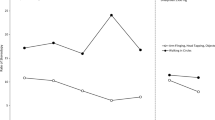Abstract
Eleven residents receiving long-term thioridazine treatment were studied while receiving their previous dose, standardized low and high doses (1.25 and 2.50 mg/kg per day), and placebo conditions. For theoretical reasons, subjects were also classified by degree of stereotypic behavior on the Fairview Problem Behavior Checklist (Barron & Sandman, 1983). Ratings of hyperactivity and self-injury were significantly lower during the higher as compared with the lower dose condition. Subjects classified as in the high-stereotypy group had significantly and substantially higher levels of maladaptive behavior on several other clinical variables. When all four drug conditions were compared, no significant drug effects were detected. However, high-stereotypy subjects responded significantly better to the drug than low-stereotypy subjects on ratings of Lethargy/Social Withdrawal and Hyperactivity on the Aberrant Behavior Checklist (Aman, Singh, Stewart, & Field, 1985a). The findings were related to previous dosage research and the literature on stereotypic behavior.
Similar content being viewed by others
References
Aman, M. G., & Singh, N. N. (1980). The usefulness of thioridazine for treating childhood disorders—Fact or folklore?.American Journal of Mental Deficiency, 84, 331–338.
Aman, M. G., & Singh, N. N. (1982). Methylphenidate in severely retarded residents and the clinical significance of stereotypic behavior.Applied Research in Mental Retardation, 3, 1–14.
Aman, M. G., & Singh, N. N. (1983). Pharmacological intervention. In J. L. Matson & J. A. Mulick (Eds.),Handbook of mental retardation (pp. 317–337). Elmsford, NY: Pergamon.
Aman, M. G., & Singh, N. N. (1986a).Aberrant Behavior Checklist Manual. East Aurora, NY: Slosson Educational Publications.
Aman, M. G., & Singh, N. N. (1986b). A critical appraisal of recent drug research in mental retardation: The Coldwater studies.Journal of Mental Deficiency Research, 30, 203–216.
Aman, M. G., Singh, N. N., Stewart, A. W. & Field, C. J. (1985a). The Aberrant Behavior Checklist: A behavior rating scale for the assessment of treatment effects.American Journal of Mental Deficiency, 89, 485–491.
Aman, M. G., Singh, N. N., Stewart, A. W., & Field, C. J. (1985b). Psychometric characteristics of the Aberrant Behavior Checklist.American Journal of Mental Deficiency, 89, 492–502.
Aman, M. G., Teehan, C. J., White, A. J., Turbott, S. H., & Vaithianathan, C. (in press). Haloperidol treatment with chronically medicated residents: Dose effects on clinical behavior and reinforcement contingencies.American Journal of Mental Retardation.
Aman, M. G., & White, A. J. (1986). Measures of drug change in mental retardation. In K. D. Gadow (Ed.),Advances in learning and behavioral disabilities (Vol. 5, pp. 157–202). Greenwich, CT: JAI Press.
Anderson, L. T., Campbell, M., Grega, D. M., Perry, R., Small, A. M., & Green, W. H. (1984). Haloperidol in the treatment of infantile autism: Effects on learning and behavioral symptoms.American Journal of Psychiatry, 141, 1195–1202.
Barron, J., & Sandman, C. A. (1983). Relationship of sedative-hypnotic response to self-injurious behavior and stereotypy by mentally retarded clients.American Journal of Mental Deficiency, 88, 177–186.
Breuning, S. E. (1982). An applied dose-response curve of thioridazine with the mentally retarded: Aggressive, self-stimulatory, intellectual, and workshop behaviors-A preliminary report.Psychopharmacology Bulletin, 18, 57–59.
Cohen, I. L., Campbell, M., Posner, D., Small, A. M., Triebel, D., & Anderson, L. T. (1980). Behavioral effects of haloperidol in young autistic children.Journal of the American Academy of Child Psychiatry, 19, 665–677.
Harris, F. C. & Lahey, B. B. (1978). A method for combining occurrence and nonoccurrence interobserver agreement scores.Journal of Applied Behavior Analysis, 11, 523–527.
Holden, C. (1986). NIMH review of fraud charge moves slowly.Science, 234, 1488–1489.
Holden, C. (1987). NIMH finds a case of “serious misconduct.”Science, 235, 1566–1567.
Jakab, I. (1984). Short term effect of thioridazine tablets versus suspension on emotionally disturbed/retarded children.Journal of Clinical Psychopharmacology, 4, 210–215.
Kalachnik, J. E. (1983).Separation of self-stimulation (stereotypies, mannerisms) and tardive dyskinesia. Unpublished manuscript, Cambridge State Hospital, Cambridge, MN.
Singh, N. N., & Aman, M. G. (1981). Effects of thioridazine dosage on the behavior of severely mentally retarded persons.American Journal of Mental Deficiency, 85, 580–587.
Slosson, R. L. (1975).Slosson Intelligence Test for Children and Adults. East Aurora, NY: Slosson Educational Publications.
Author information
Authors and Affiliations
Additional information
The authors thank Dr. C. Vaithianathan for medical supervision of subjects in this study, Carolyn Teehan for supervision of the direct observations, Tony Gerrard (Auckland Hospital Pharmacy) for preparation of the medication, Sarah Turbott for assistance with the statistical analyses, and Marsha Aman for typing the manuscript. We thank the following staff members for carrying out direct observations: Sherri Briggs, Kathryn Buckman, Sue Drower, Hilary Harris, Sheryl Oliver, Glenda Rathe, and Raewyn Stevens. This study was supported by a grant from the Medical Research Council of New Zealand to Dr. M. G. Aman.
Rights and permissions
About this article
Cite this article
Aman, M.G., White, A.J. Thioridazine dose effects with reference to stereotypic behavior in mentally retarded residents. J Autism Dev Disord 18, 355–366 (1988). https://doi.org/10.1007/BF02212192
Issue Date:
DOI: https://doi.org/10.1007/BF02212192




